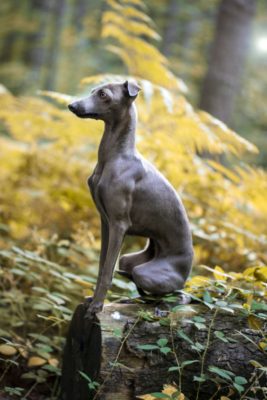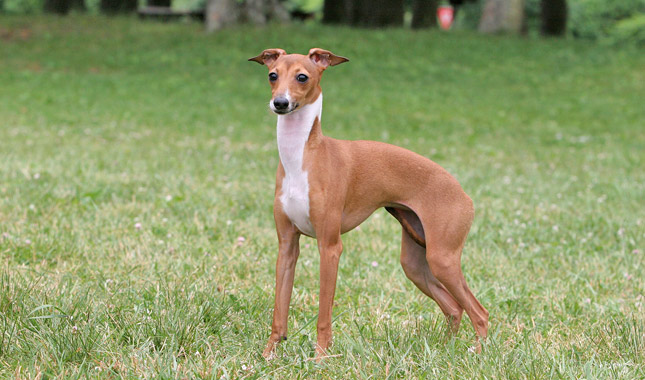Italian Greyhound

An extremely well-balanced character characterizes the Italian Greyhound. Friendly, affectionate, gentle, playful – so describe the Italian Greyhound. It will adjust to your family environment and will not break the rules. Sociable but shy, she needs to socialize as early as possible and learn to cope with stress. The Italian Greyhound has a developed emotional side so that it can be sentimental.
Table of Contents
Breed Information
| Another Name | Italian Sighthound, Piccolo levriero italiano |
| Origin | Italy |
| Height | 32-38 cm |
| Weight | 3.6-5 kg |
| Fur | Short, smooth, straight |
| Color | White, pale, red, gray-blue |
| Lifespan | 12-15 years |
| FCI Classification | Sighthounds |
| Group | Hunting dog, ornamental dog |
| Price | $400-1100 |
Breed Photos
Origin History
The name of the breed Italian Greyhound, known as the Italian lesser greyhound, comes from the French word lièvre, which means “hare”. And it is not strange that the breed was given such a name because the Italian Greyhound is the smallest representative of the greyhound group. The Italian Greyhound breed existed as far back as 3000 years B.C. in Egypt. It can be confirmed by the tiny mummies of dogs found in the Pyramids. The Italian Greyhound is present on the wall paintings of temples of the time of ancient Egypt. The Italian Greyhound is second only to horses in the number of images. It is unclear how the Italian Greyhound came to the territory of present-day Italy. Some believe that Julius Caesar imported the Italian Greyhound in the fifth century B.C. as a Cleopatra gift.
Because of its small but exquisite appearance, the Italian Greyhound was the first dog breed to be bred as an ornamental dog. It is believed that the Italian Greyhound was bred to hunt small game. It participated as a hunting dog in hunting hares. Moreover, it was kept in homes as a rat catcher dog.
During the Renaissance, the Italian Greyhound was a favorite of aristocratic courts. The dog became a muse for many artists of the time. It was portrayed in the narrative, portrait, and biblical paintings. Such monarchs as Catherine de Medici, Henry VI, Charles I, and Queen Victoria kept Italian Greyhounds. However, Frederick the Great probably surpassed them all. His court numbered about 300 Italian Greyhounds.
During World War I and World War II, many Italian Greyhounds were exterminated. The breed was on the verge of extinction, but a small population of Italian Greyhounds in America saved the situation. In Italy, the Italian Greyhound is still used as a hunting dog, but it often acts as a decorative dog.
Appearance
The Italian Greyhound is not a diminutive copy of other greyhounds. The Italian Greyhound is incredibly graceful. This dog is confident in its blue blood and looks down on others. The Italian Lesser Greyhound physique is slender, the skin is thin, and there are almost no fatty deposits. Well-developed musculature, the abdomen tightened. The chest is deep. The dog has strong limbs, especially the hind limbs, which allow it to run with great speed for short distances. The dog’s paws resemble those of a hare. The attribute of the Italian Greyhound is its coat, which is shiny and smooth as silk. The dog’s head is narrow and oblong, with a smooth transition from forehead to nose. Its large dark eyes stare into the distance with pride. The dog’s rose-shaped ears hang loosely or pressed to the head. The back is straight, and the tail is thin and taut.
Character
An extremely well-balanced character characterizes the Italian Greyhound. Friendly, affectionate, gentle, playful – so describe the Italian Greyhound. It will adjust to your family environment and will not break the rules. Sociable but shy, she needs to socialize as early as possible and learn to cope with stress. The Italian Greyhound has a developed emotional side so that it can be sentimental. This dog is very sensitive: it will be unhappy in an aggressive and cruel environment.
Despite its small size, the Italian Greyhound is an athlete at heart. It likes to move and run. A Italian Greyhound is not used as a guard dog, but it can make a noise in case of danger. The Italian Greyhound loves to play with children, but it is necessary to see that the child’s movements do not harm the fragile animal. Italian Greyhound breed is suitable for the elderly, a young family without children, or adult children.
Care
The Italian Greyhound’s smooth coat is not difficult to care for because the hairs are thin and short. It is necessary to bathe the dog when necessary. Italian Greyhounds are hard to bear the cold, so you should have a towel handy so that you can quickly dry the pet. The most important aspect should always be the care of the Italian Greyhound’s teeth. The brushing regimen should be 1-2 times a day. You should train the dog as early as possible, even though the full set of teeth will be only by the age of six months. The Italian Greyhound is an ideal apartment dweller. Keeping a Italian Greyhound in an enclosure is strictly forbidden. By behavior at home, the dog is similar to a cat: it likes to sit on the owner’s arms for a long time.
Training
Like most greyhounds, the Italian Greyhound responds well to training with positive reinforcement. If physical force is used during training, the dog may refuse to interact further. The dog should be praised and rewarded with treats for correctly executed commands. The most difficult thing is to accustom the Italian Greyhound to the toilet. It is due to the peculiarity of the dog’s bladder and its dislike of wet weather.
Common Diseases
The Italian Greyhound is susceptible to quite a large number of pathological conditions. The most common diseases of Italian Greyhounds:
- hypothyroidism;
- periodontitis;
- dislocation of the patella;
- epilepsy;
- cataract;
- retinal atrophy;
- hip dysplasia;
- sensitivity to anesthesia.
The skeleton of an Italian Greyhound is fragile, so you need to make sure that the pet is not injured.
Nutrition
The diet plays a vital role in the condition of the Italian Greyhound’s bones. That is why the dog’s diet should contain a lot of calcium and protein. Chicken meat, veal, and beef are suitable for the diet. Dogs benefit from vegetables, porridges, and dairy products.
 Segugio Italiano
Segugio Italiano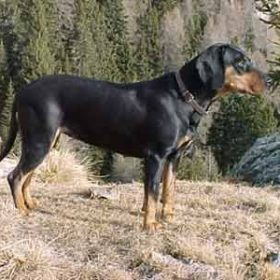 Austrian Black and Tan Hound
Austrian Black and Tan Hound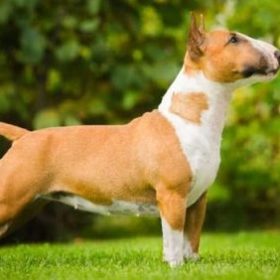 Miniature Bull Terrier
Miniature Bull Terrier Pharaoh Hound
Pharaoh Hound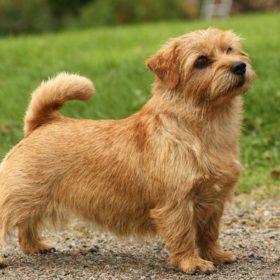 Norfolk Terrier
Norfolk Terrier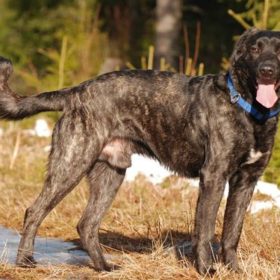 Castro Laboreiro Dog
Castro Laboreiro Dog
